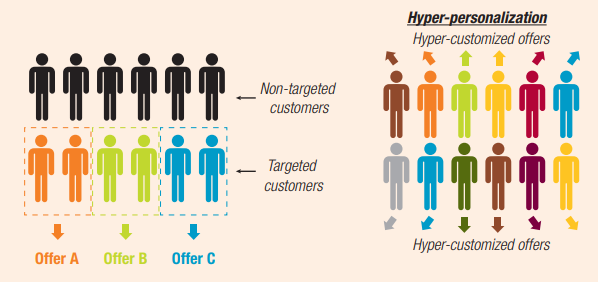Welcome to the dynamic world of hyper-personalization. This concept is revolutionizing how businesses interact with their customers. Hyper-personalization harnesses the power of big data and analytics. It’s transforming modern marketing strategies. Our journey today explores this multifaceted domain. We’ll understand how it’s reshaping customer experiences.
The Evolution of Personalization

Personalization in marketing has a rich history. It began with mass marketing. Then, it moved to market segmentation. Now, we’re in the era of hyper-personalization. But what’s different now? Hyper-personalization goes beyond traditional methods. It leverages emerging technologies to create highly individualized customer experiences. We’ll explore these changes and their driving forces.
The Backbone of Hyper-Personalization
Big data is crucial to hyper-personalization. It’s about massive volumes of data. These come from diverse sources. Big data analytics is key. It turns vast datasets into personalized insights. We use advanced techniques here. Data mining and predictive analytics are just the start. They help in understanding and anticipating customer needs. This section delves into how big data fuels hyper-personalization.
Touchpoints – Gateways to Customer Insights
Touchpoints are crucial in hyper-personalization. They’re where customers interact with your brand. Each touchpoint, from social media to customer support, offers valuable data. We’ll analyze these digital touchpoints comprehensively. You’ll learn techniques for collecting and analyzing data at each point. We’ll also discuss integrating offline and online data. This approach offers a complete view of customer interactions. It’s key to achieving effective hyper-personalization.
Technological Enablers of Hyper-Personalization
Technology is a powerhouse in hyper-personalization. AI, machine learning, and data science are at the forefront. They enable sophisticated personalization strategies. We’ll explore their roles in depth. Cloud computing and big data platforms are also vital. They manage the vast datasets needed for hyper-personalization. Additionally, we’ll examine the impact of IoT and wearable tech. These technologies are shaping personalized customer experiences in novel ways.
Industry-Specific Applications
Retail Industry

In retail, hyper-personalization is about understanding shopping behaviors. Retailers analyze purchase history and online browsing data. This helps tailor product recommendations and promotions to individual customers.
A fashion retailer uses customer data to suggest items that match previous purchases, increasing sales and customer satisfaction. Companies that excel at personalization generate 40% more revenue from those activities than their slower-growing counterparts.
Finance Industry
Banks and financial institutions use hyper-personalization for customer service and product offers. They analyze transaction histories and customer interactions to provide personalized financial advice.
A bank employs chatbots that give customers personalized advice based on their spending patterns and saving goals.
According to a survey conducted by Datos Insights, an overwhelming 89% of U.S. consumers indicated that trust is very or extremely important when choosing their primary financial institution.
Healthcare Industry

Hyper-personalization in healthcare focuses on patient care. Medical providers use patient data to tailor treatment plans and health recommendations.
A healthcare provider uses patient data to send personal health tips and reminders for check-ups, improving patient outcomes.
Recruitment Agencies
Recruitment agencies use hyper-personalization to match candidates with job openings. They analyze candidate profiles, job histories, and preferences to suggest suitable job opportunities.
An agency uses AI to analyze resumes and job descriptions, efficiently matching candidates to roles that align with their skills and career aspirations.
In each of these sectors, it enhances customer experiences, improves the candidate experience, increases efficiency, and drives better outcomes. These case studies showcase the power of leveraging individual data points to meet specific industry needs.
Personalization in Marketing Campaigns

In the realm of personalization in marketing, crafting campaigns that resonate with individual customers is key. Strategies for creating such campaigns involve deep data analysis to understand customer preferences and behaviors. This helps in delivering tailored messages that strike a chord with the audience. Leveraging big data and analytics enables marketers to create more accurate and effective hyper-personalized campaigns
Evaluating the effectiveness of hyper-personalized marketing is crucial. It involves measuring engagement rates, conversion metrics, and customer feedback. These insights help in refining strategies for even better personalization in future campaigns.
Several tools and technologies are instrumental in aiding personalized marketing. Customer Relationship Management (CRM) systems, marketing automation tools, and AI-powered analytics platforms are some examples. These tools gather and analyze customer data, enabling marketers to create more targeted and effective campaigns.
Challenges and Solutions in Implementation
Implementing hyper-personalization in marketing isn’t without its challenges. A common issue is finding the right balance between scalability and customization. Businesses often struggle to personalize at scale without losing the individual touch.
To address these challenges, businesses need to employ a combination of technology and strategy. Advanced data analytics can help in understanding customer segments more deeply, enabling scalable personalization. Meanwhile, AI and machine learning can automate many aspects of customization, making it more efficient.
Best practices for effective implementation include maintaining data quality, respecting customer privacy, and continuously testing and optimizing strategies. By focusing on these areas, businesses can overcome challenges and successfully implement hyper-personalization in their marketing efforts.
Ethical Considerations and Data Privacy
In this section, we dive deep into the critical aspects of ethical considerations and data privacy within the context of hyper-personalization in marketing:
Privacy Concerns and Ethical Implications
The collection and utilization of customer data give rise to significant privacy concerns and ethical implications. These include potential data breaches, unauthorized access, and the fine line between providing personalized experiences and being intrusive. Businesses must grapple with the ethical responsibility of securing and protecting customer data.
Navigating Global Data Protection Regulations
Navigating the complex landscape of global data protection regulations is essential. Key regulations such as the General Data Protection Regulation (GDPR), California Consumer Privacy Act (CCPA), and similar laws worldwide impact hyper-personalization practices. Understanding and adhering to these regulations are paramount for organizations, not only to comply with legal requirements but also to maintain the trust and confidence of their customer base.
Building a Privacy-Centric Approach to Hyper-Personalization
To address the ethical and privacy concerns associated with hyper-personalization, businesses must adopt a privacy-centric approach. This approach encompasses a spectrum of strategies and best practices. It includes implementing robust data protection measures such as encryption and stringent access controls to safeguard sensitive customer information. Obtaining informed and explicit consent from customers regarding data usage is pivotal. Transparency in data handling is also emphasized, ensuring that customers have clear visibility into how their data is collected, processed, and utilized for personalization purposes. By prioritizing data privacy and ethical considerations, organizations can cultivate stronger customer relationships, foster trust, and establish a solid foundation for successful hyper-personalization strategies.
The Future of Hyper-Personalization
In this forward-looking section, we delve into the future of hyper-personalization, examining emerging trends, making predictions, and exploring the potential impact of nascent technologies on the landscape of personalization:
Emerging Trends and Future Predictions in Personalization
The future of hyper-personalization is marked by an array of emerging trends that redefine how businesses interact with customers. We analyze these trends, including the growing utilization of augmented reality (AR) and virtual reality (VR) to create immersive and personal experiences. Additionally, we predict that hyper-personalization will extend its reach beyond marketing, infiltrating sectors like healthcare and education. The future promises more customization, real-time interactions, and deeper customer engagement.
In conclusion, our exploration of hyper-personalization has uncovered a wealth of insights and takeaways. We’ve delved into the critical role that hyper-personalization plays in shaping the future of customer experience. As businesses navigate this ever-evolving landscape, it’s evident that harnessing the power of hyper-personalization is not just a choice; it’s a necessity. It’s what sets forward-thinking companies apart.
As you embark on your journey towards personalized customer experiences, remember that staying ahead of the curve requires innovation and the adoption of cutting-edge technologies. Gotoro’s programmatic job advertising technology stands as a testament to the transformative potential of hyper-personalization. To see it in action and revolutionize your approach, we encourage you to request a demo today.


